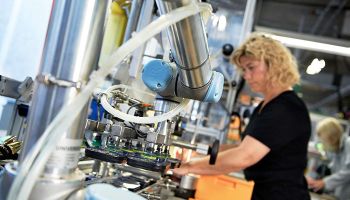When to Use Collaborative Robots for Manufacturing
- October 29, 2019
- Best Practices
- Automation
Collaborative robots can offer a lot of potential to manufacturing applications such as repetitive tasks, collaborative environments, and variable production runs.
Collaborative robots differ from traditional industrial robots and there has been a lot amount of hype because of the potential benefits they can provide for manufacturing. However, the International Federation of Robotics (IFR) estimates only 4% of all robots sold in 2017 were collaborative.
While this number is expected to rise quickly over the next several years, collaborative robots are still a young robotics technology. Given their short amount of time as a viable automation solution, it can be difficult to determine when a collaborative robot is best for an application. First, it may be helpful to fully understand the difference between the two forms of robots.
Collaborative Robots vs Industrial Robots
Industrial robots typically automate highly dangerous tasks, working with high temperatures, large objects, sharp tooling, or any combination of these. For this reason, they’re typically surrounded by large fencing that prevents human workers from interacting with the robot for any reason other than maintenance.
Collaborative robots, on the other hand, feature rounded designs with force-limitations to minimize the potential for injury should any unintended contact occur. They are intended to work alongside humans and aren’t barricaded behind safety fencing. Some collaborative robots shut off when a human worker is too close, then resume when a safe distance is kept. Collaborative robots have a number of safety features that allow them to be used in scenarios where industrial robots never could.
Three collaborative robot applications in modern manufacturing
Collaborative robot technology is advancing rapidly – they can be deployed in many different ways. As a general rule of thumb, there are three scenarios in which a collaborative robot is ideal.
- Repetitive and unergonomic tasks.
Tedious and physically-demanding tasks can be dangerous for human workers. Collaborative robots are effective at automating such tasks, like holding heavy parts, to allow human workers to be more productive with less risk of injury. - Short or variable production runs.
Collaborative robots are more flexible than industrial robots. They can be integrated and programmed far quicker and with greater ease. This makes them more profitable in environments where the robot has to conduct various different tasks. - Collaborative environments.
Collaborative robots are meant to interact with human workers. In scenarios where a robot can only complete a portion of the work at hand, and a human worker can more profitably complete this work, a collaborative robot will be the best option.
Collaborative robots are a new form of robotic technology with great promise. There are several scenarios in which they are better suited than industrial robots, and they come with several productivity benefits.
Author
This article originally appeared on the Robotics Online Blog. Robotic Industries Association (RIA) is a part of the Association for Advancing Automation (A3), a CFE Media content partner.
